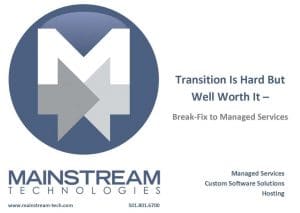 From Break-Fix to Managed Services
From Break-Fix to Managed Services
A Managed Service Provider’s (MSP’s) true value to the client is the peace of mind they receive by knowing their technology is working properly. In return, the MSP receives a predictable monthly fee for their services. This relationship gives the client the assurance they need to turn their attention from their technology to more pressing issues directly related to the core business.
Fundamentally, a managed service provider aspires to maximize the client’s IT investment by delivering:
- Increased stability and reliability by
- Real-time system monitoring
- Resolving performance issues before they cause downtime
- Improving system efficiency and performance
- Taking care of routine but essential system maintenance,
- Establishing short, mid, and long-term technology goals to make sure the technology is aligned with the business,
- The ability to free up internal staff so they can focus on strategic priorities,
- Access to a broader set of skills that would otherwise be too costly to bring in house,
- The ability to document and preserve institutional knowledge.
Transitioning from break-fix or reactive support (where the provider performs services on demand) to managed services is a significant paradigm shift. This transition is often called onboarding and is composed of 3 phases which begin with the installation of monitoring tools, tackling performance issues, and ending up with a 3-5 year technology plan. Onboarding is challenging and sometimes even painful depending on the state of the network when the MSP gets on the job.
Onboarding
In order to have continuous visibility into system health, monitoring tools are loaded onto the system(s) in phase 1. Once installed, they’re customized to accurately report on network activity and health.
The provider will also immerse themselves in the applications that drive the business and gather network documentation during phase 1. This documentation will include all of the network components as well as any and all relevant vendor information. Once the provider has completed these tasks, they will have a pretty good idea of what the critical factors are for improving system performance.
Phase 2 is dedicated to remediating any performance issues found in phase 1. Depending on what was uncovered in phase 1, phase 2 could be brief or it could extend over a long period of time.
Phase 3 is when the State of the Network (overall findings) and recommendations are delivered to the client. These recommendations are focused on aligning the technology with the needs of the business and are the cornerstone of all future planning efforts. Some of the issues covered in these findings are DR issues such as Restore Time Objective, Restore Point Objective, and the business continuity requirements as well as other relevant topics. The net result is that as the onboarding process winds down, the client is well on the way to getting the most out of their technology with a 3 to 5-year technology plan to manage to.
Change is never easy, especially when you’re transitioning from break-fix to managed services. More often than not, once the MSP gets on the job, they will find unanticipated surprises that will complicate the transition and impact client perception. The key to a successful relationship is over-communicating between both parties.
Remember if you choose to go down the path of managed services, there will be a payoff at the end of the day, but it may take some time before you reap the benefits.






